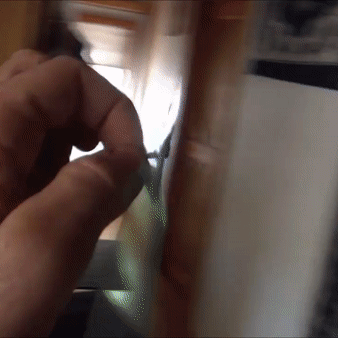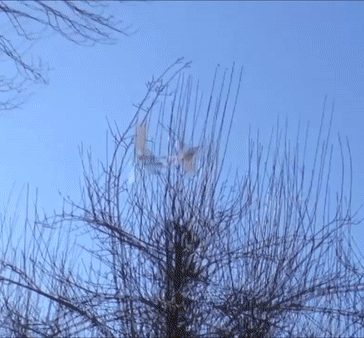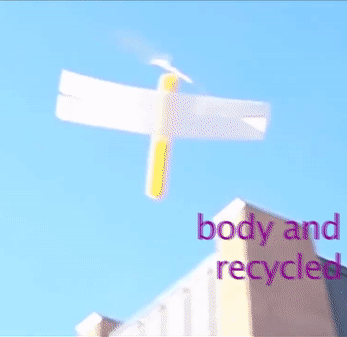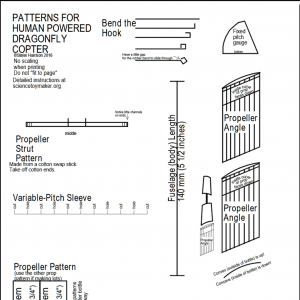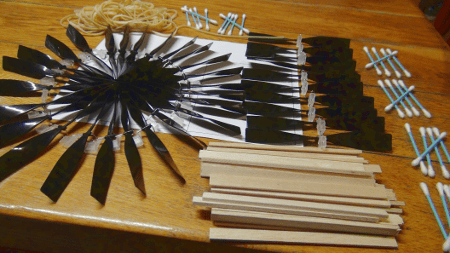If YouTube is blocked at your school, try this MPG file (18MB)
Dragonfly Helicopter Index
- Introduction and Q&A
- Dragonfly Helicopter from Common Materials
- Make an Easy Dragonfly Helicopter
- Make a plane from a dragonfly helicopter
- Make a Dragonfly Helicopter with an adjustable Propeller(Eco-E Copter)
- Science of Dragonfly Helicopter
- Dihedral Magnus Effect Gliders
- Patterns and Printables
- Buy Dragonfly Helicopter Kits
- Gallery
Instructions for the easier version of Dragonfly Helicopter with an already-made injection-molded propeller.
Make a Dragonfly Helicopter with an adjustable Propeller (Eco-E) that will go higher than the tallest trees.
Here is some science of Dragonfly Helicopter.
Make and fly a simple kind of glider, or send it high up in helicopters.
Dragonfly Helicopters Are a Great Beginning Flight Project!
There is something empowering about making the propeller from a trashed 2-liter drink bottle; and wind up with a propeller that's superior to commercial propellers. Your flying machine will go higher than the tallest trees with no batteries (assuming you wind it). Unlike model airplanes, which can be plagued by stability problems from a slightly warped or crooked wing, helicopters always fly true. Nobody is excluded. Windup helicopters are so inexpensive that whole classes of students can make them for much less than a dollar for each project.
Q&A
Below are some questions and answers. When there are numbers, they refer to where in the video (minutes and seconds into the video) to see what the text is describing.
If you have other questions about Dragonfly Helicopters, contact me or leave a message in the comment section at the bottom of this page, and I’ll answer them.
Q. Where are the instructions for building the helicopter?
A. Click here. This is called the Eco-Empirical (Eco-E for short) design because it's made largely of recycled stuff and it's really good for experimenting with. That distinguishes it from a simpler design...
Q. Is there a simpler, faster, easier design for younger kids?
A. Yes, it's called the Easy Dragonfly Helicopter.
Q. Do we buy the Dragonfly Helicopter or make it?
A. Yes…er, both. You can make either design from a kit or buy them completely ready-to-fly (well, you still have to wind them).
Q. What if I don't want to make them from a kit?
A. At the end of the Eco-Empirical instructions there are some tips for making a propeller from stuff around the house. So, you use a steel paper clip instead of the aluminum wire that would be in the kit. It would not be variable-pitch (change the propeller angle) the way the kit is. So far, still ok. But, the kits also supply rubber that is specifically made for model airplanes and there is absolutely no comparison between that and regular office or school rubber bands. I'm not saying model rubber is a little better; I'm saying--based on lots of trials--that it's an order of magnitude better. Why spend time making a very high-quality flying machine and then power it with a low-quality rubber motor? Fortunately, you can buy small amounts of rubber.
Q. How high to the helicopters go?
A. If you wind them up enough, Human Powered Dragonfly Helicopters will go way higher than tall trees. The heavier kind made with commercial propellers do not go as high, but will still go as high as a big house or hit the ceiling of a gym, auditorium or flight hanger.
Of course, how high the copters go depend on how much you wind them up(1:13). It takes beginners some time to understand that they can wind up at least 160 turns in warm weather. But rubber loses some of its stretch when it's cold, so do not wind up as much in cold weather.
When you are ready to go beyond basic flying, there are other strategies for going even higher. You can make the rubber bands longer. I don't do that with beginners because there is more winding to do before it flies at all. But when you wind it a lot, you get more power. Experts make the rubber loop long so it's very loose. They also wind it up with a special winding device which saves time. And they stretch it as they start winding, slowly un-stretching as they wind. Serious pilots add lubrication (not oil-based) to the rubber and use geared winders so you can wind it up more. Green soap and glycerin was the traditional way; now silicone based lubricants are used also.
Q. Can you really send gliders up with the helicopters?
A. Yes, you can make a very simple paper glider that you wedge under the rubber band. As the rubber band unwinds, it pushes out the gliders. You can see how to make the gliders here and I am making a web page dedicated to making releases more consistent as people like you experiment and find eve better ways to do it.
Q. Why did you make the helicopter look like a dragonfly?
A. I didn’t—at least not intentionally. I set about to make the most efficient, highest-flying helicopter. The wings serve two purposes: to always make it go up, and to keep the body (fuselage) from spinning too much so the propeller can spin more. I discovered that long, thin wings attached near the top worked best…and—hey—it looks so much like a dragonfly!
Q. Do the rubber bands break?(1:13)
A. It is quite rare for Tan Super Sport rubber to break. In fact, most people never wind them anywhere close to their capacity. However, we send extra rubber bands with our Dragonflies just in case. You can also buy enough rubber for 6 helicopters inexpensively because we can send it in an envelope.
Q. Can you make the Dragonfly autogyro down?
A. Yes, by twisting the wings—left up, right down as the wing ends face you—then the whole Dragonfly will turn like a helicopter once it has reached its peak and starts down(2:32). It’s pretty amazing, when launching with no wind, that even when the copter goes really high, it will land very close to where you launched. However, if there is even the gentlest breeze, it will land far away.
Q. Can you change the flight characteristics of the Dragonfly?
A. Yes. Usually the Dragonfly heads straight up. But I’ve found that as I tape the wings closer to the propeller and give the wings less dihedral (dihedral is the curve of the wings), then the flight of the Dragonfly becomes more erratic. And that can be cool because it reminds me of the way real dragonflies zigzag so abruptly!(2:55)
Q. How strong are Human Powered Dragonfly Helicopters?
A. The helicopters can bash into a ceiling with no harm. If someone can hold a paper airplane without smashing it up, then they should be able to handle a Dragonfly. The weakest part of Dragonflies is the wing. It is made of lightweight foam. If you pull it out of a bush or tree, the foam might break. But no worries, just tape it and it’s good as new.(3:06)
Q. Can you change the pitch of the propeller?
A. The pitch is set to be ideal. However, if you want to experiment, you can change it by pinching the glue joints (where the shaft glues to the prop spar, an where the prop spar glues to the blade) so they don’t break. So when you twist, it only twists the propeller spar, which is the stick part of a cotton swab stick(3:11). If you bend it enough, it will not spring all the way back to its original angle. Obviously, if you do this too much or if you don’t stabilize the glue joints enough, something will break. But it is interesting to see how a more aggressive pitch makes the copter go higher—to a point. Then it stalls and is useless. DO NOT TRY THIS TWISTING IN COLD WEATHER!! I just discovered this the hard way. Only do this when it's warm.


